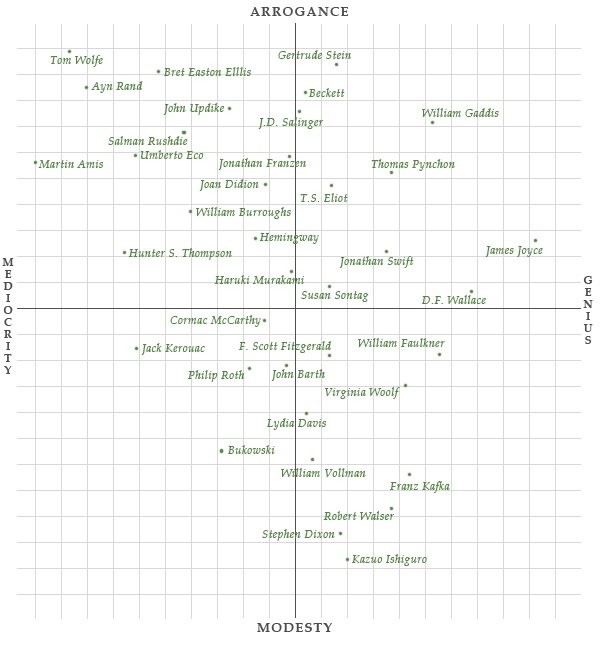“THE COLORS TODAY ARE GOING TO WAKE YOU UP!!”
Lindsey Wixson is primarily known in the fashion industry for her unique look: her dramatic lips, playful pout and her trademark gap between her two front teeth. The public narrative Wixson and her representatives have crafted for her is a rather detailed one, even providing information about the dreams and aspirations of the young woman had she followed a different path. During her childhood Wixson wanted to follow a culinary or legal career.
Her professional goals became exclusively fashion-oriented in the brief outpour of success that occurred after Steven Meisel chose her for the cover of Italian Vogue. After the cover, Wixson was booked for two luxury brands, Prada and Miu-Miu, both as exclusives. Ever since, she is a widely recognized face and prominent model.
In an interview with WWD, Wixson discussed how she understands her path and her ascend to success. She single-handedly cites reading a Reader’s Digest (RIP!) in a bathroom when she was 12 as the catalyst for her pursuit to become a model: “It was about how Bill Gates — the millionaires — got big. It was talking about how they took the chance and they took their opportunities and they took it to a whole other level.”
*
Do you ever look around at the world, noticing the people surrounding you? Wondering how they understand their existence, how their brain functions and to what degree their understanding of things is similar to yours?
I do. That is why this video-mosaic of the famous model Lindsey Wixson is possibly the most fascinating thing I have seen in the recent past. It bewilders me to see her and her responses to reporters asking her questions about her experience and opinions as she is preparing for fashion shows. Within about a minute, Wixson manages to fit these gems:
The colors today are gonna wake up. They’re going to be, like, ‘WAKE UP, GUYS!’
BEAAAAUUUTIFULLLL! Oh my god, look at this dress! It’s Roberto Cavalli, it’s crazy!
It’s over the top, glamour, period-retro
I would like to become a pilot.
I feel like a woman from Mars… Obviously, I am, like, taking over the world. Pedal to the medal!
WHAT IF WE LIVED IN A BACKWARDS UNIVERSE WHERE JEREME DEAN LOVED STEVE ROGGENBUCK AND TOES GREW FROM YOUR HEAD INSTEAD OF YOUR FEET?? (by Chris Dankland)
***
Rauan Klassnik “Backwards”: I’ve seen you say many positive things about ‘Alt Lit’ and, specifically, i think, Steve Roggenbuck. But do you really support these yung, dum YOLO youngsters? (& plz elaborate)
Jereme Dean “Backwards”: (Before I begin, I’d just like to congratulate the Houston Texans on another incredible winning season. The Texans are truly the best team in the NFL today.)
Yeah I love Alt Lit and Steve Roggenbuck so much, thanks for asking! Alt Lit is the latest iteration of writers who are using the internet as a tool to create and promote writing—their own, and others. They’re just building on what other internet writers have created before them. Blake Butler, Sam Pink, Tao Lin, Daniel Bailey, Mike Young, Jimmy Chen, Brandon Scott Gorrell, etc: these are the types of trailblazing writers that helped to create Alt Lit in the first place. If you have a broad definition of Alt Lit as writer + internet, as I do, I would say that all those writers I mentioned are as much a part of Alt Lit as Roggenbuck or anybody else.
Alt Lit is to writing what a cafeteria is to school education, and I don’t just mean a place where you can find the nutritious and delicious. :D Alt Lit is a place where you can sit with your friends and take a break from the constant academic manifestos, lifeless conceptualism, and intellectual dick measuring contests of the academic literary world. Too much of that kind of stuff can easily burn you out.
Now, let’s just move onto the subject of Steve’s positivity.
I luv it!! In particular I love how Steve’s message to embrace life, boost others, and ‘make something beautiful before you are dead’ are responses to a very dark truth that we all must face: that one day you will die, you never know when—and once you are gone, you will be gone forever. Roggenbuck reminds his audience of this constantly. There have been many times that I’ve clicked on something of Steve’s and felt as if I were being shaken awake from a deep sleep, simply by being reminded of the bitter truth that my time on earth is constantly disappearing, second by second. It is a reminder to me that my life is going on RIGHT NOW and I better pay attention to it. For me and for many others, this idea isn’t superficial or vapid.
One of my favorite examples of this type of positive message is ‘STOP PRETENDING IT’S BORING TO BE ALIVE’
I think a video like that is incredible and genuinely inspires me, but some people might have a different reaction. That’s fine with me. I certainly wouldn’t dismiss how other people READ MORE >
I like Marcus Kelly a lot

In my last post, I mentioned that I wanted to write a little bit about the actor and singer Marcus “Marky” Kelly, who had minor-but I think significant-career in show business from the late 1950s through the 1960s. The highlight of it all was, of course, his teen idolhood in the early 1960s. I had assumed Kelly was gone for good, and quite possibly dead, until I discovered a movie called Filtered Water (director unknown, writer unknown, producer unknown, actors unknown) in my mailbox a few months ago. The movie featured an old actor who I think might be Kelly.
But let me make it clear: I am not 100% sure that the old actor in Filtered Water is Kelly. There are, however, clues. There is a physiognomic similarity-Kelly had bright blue eyes, and a signature half-smile. The actor in the film has bright blue eyes, and a familiar half-smile. There is the timeline-Kelly was born in 1940, and the actor appears to be in his 70s. (And I know this because my folks are in their 70s, and if I look at an old picture of my Dad and a new one, old pictures of Kelly and a screenshot of the actor look to have an uncannily similar progression. The same wrinkles, the same advancing tenderness to the eyes, the same added colors in the complexion. If its him, he’s aged like my dad has aged.) And there is the voice. The actor’s voice sounds like what Kelly’s voice would sound like if it fell apart and was rebuilt. Like a voice does when we age. READ MORE >
Virtualis and Regeneration
 Virtualis: Topologies of the Unreal
Virtualis: Topologies of the Unreal
by David Dowker & Christine Stewart
BookThug, 2013
81 pages / $18 Buy from Amazon or SPD
I. “We are gathering interior circumference.”
“No longer a phantasm and not yet a sign, the unreal object of melancholy introjection opens a space that is neither the hallucinated oneiric scene of the phantasms nor the indifferent world of natural objects…. The topology of the unreal that melancholy designs in its immobile dialectic is, at the same time, a topology of culture.” – Giorgio Agamben, Stanzas: Word and Phantasm in Western Culture
Virtualis is a dense and lyrical book mediated by visionary and philosophical language, commemorating “the vibratory distances between dreams.” Dowker and Stewart use exquisitely ornamental language to exalt the majesty of the senses in poems I found to be radically potent. This book weaves a kind of lexical magic as threads of stunning lyricism and metaphysical fantasia so vibrant it feels like a synesthetic dream. These poems appear as phantasms from the depths of the imaginal – bridging philosophy, musical language, at once odd and angular yet exquisitely crafted, like Brancusi’s Bird in Space. This book includes a reading list of philosophy books that are quoted, including works by Agamben, Deleuze, Benjamin and others.
Virtualis functions as a voyage into pure consciousness. The text’s mindfulness is a rich ore of ekphrastic palingenesis. The mix of some pretty heady philosophical language with soaring lyrical fantasia is something I find totally stimulating: “Our vocabularies maintain subjective principles not immediately apparent as the (inexplicable) lure of verdure.” The book’s philosophical language gives weight to its ethereal fantasia, grounding the book’s assemblage point in a preternatural realm of euphoric convergence weighted in the shells of some spectral egg, creating layers upon layers through which these poems can be enjoyed.
“Genus is dissolute. Vagrant is its range. It is the logical effluvium of some proto-binomial urge. Brute geogeny overwhelms ontology. Basic array of itinerant fragrance and mute fruition.
Spaces are their own bloom. A gauge of any and several congenital avowals. This rate brain interpretation lichen aligned phosphorous chorus to appall us (o rhodopsin bop voluptuary).
To divulge is lysergic (time-section light-thought in lilt). It is febrile nostalgia. Rapt state. Atavistic splendour of that chymical epoch.
There are silences, mania . . . convalescence.
Distractions avalanche here. See selah –– a shapely cadence. The converted word installed in perfect retrograde.”
This is pretty ethereal stuff, and these abstractions generate a vortex of ideation that moves me as a reader into a realm of ideas for which there are no words. Imaginal texts can lure us to a state of the royal art, Raja-Yoga, where the mind is a kind of kaleidoscope fluctuating between realities all condensed into a multilayered assemblage.
Virtualis is a confluence of worlds in the sense that this book is a meeting place of ideas, of forms, of Beauty. The condensation of vertical space here is so utterly ripe with alchemical gold, forever “in the process of disassembling the semblance / of an open space.” Virtualis exemplifies the rajasic qualities of energy, movement, generation and animation. These are poems of “a mostly ghostly trace” that move through a luminous realm of alternative perceptions toward an aphasic state devoid of all mediocrity and ugliness. Its singular bravado is a daring exploration of sonic beauty and the integrated psyche. I commend the authors for their generosity of vision, and for willing to look “along the fringes of consciousness.”
December 6th, 2013 / 12:00 pm
when my dad texted me Nelson Mandela was dead the first thing that went through my head was Johnny Clegg and Savuka’s song “Asimbonanga”
(“We haven’t seen him” — 1987)
which called for Mandela’s release from prison
***
Oh the sea is cold and the sky is grey
Look across the island into the bay
We are all islands till comes the day
We cross the burning water
***
(Mandela joins Clegg on stage at about the 2:40 mark. And then speaks a little. And dances.)
Screaming Monsters and Sordid Gays: Ian Bogost’s Alien Phenomenology
I was really looking forward to reading Ian Bogost’s philosophy book, Alien Phenomenology, or What It’s Like to Be a Thing. Two girls who I absolutely admire — one who writes criticism about Thoreau, one who writes plays about Louis Braille — placed praise upon the book, and I was prepared to do similarly.
Ian’s book is bound to object-oriented ontology, a philosophy that posits that “nothing has special status, but that everything exists equally — plumbers, cotton, bonobos, DVDs.” For Ian, the world is composed of units, where “something is always something else.” Humans, the stars of so many philosophies, can neither be separated nor elevated above other things because those things are a part of them and they are a part of those things. While Kant (a bland German boy), Heidegger (a curious Nazi boy), and others put people on a peerless pedestal, Ian puts them in messy dot where millions of encounters occur at once. As Ian explains:
On August 10, 1973, at a boathouse in Southwest Houston, the shovel of a police forensics investigator struck the femur of one of the seventeen corpses excavated that week, victims of serial killer Dean Corll.
The boathouse, the shovel, the police boy, the serial killer — each is a unit, and each unit leads to other units. The serial killer boy probably possessed a mommy and daddy, and his mommy and daddy are units who are entwined with more units. Object-oriented ontology suggests the unceasing character of the Nazis, who were invariably inserting themselves into more land, lives, and histories. Units are all over, and, during World War Two, so were the Nazis.
But not all of object-oriented ontology can be compared to screaming monsters who slaughtered six million you-know-whos and five million ummms. Some of Ian’s philosophy aligns with utterly unpleasant people, like Walt Whitman and Allen Ginsberg. Each of these canonized homosexuals has a penchant for lists. Whitman enumerates his electrified body parts while Ginsberg tells of the objects that have transfixed his tushy. For Ian, “Lists remind us that no matter how fluidly a system may operate, its members nevertheless remain utterly isolated, mutual aliens.” Whitman-Ginsberg types show this shared separateness in a most sordid way. Queer theorist Tim Dean details how homosexuals disclose the inevitable objectification of s-e-x. Disputing Andrea Dworkin’s belief that porn “dehumanizes those whom it fetishizes,” Dean says that all s-e-x, not just the porn kind, “fragments and particularizes.” Such fragmentation is disgustingly displayed in the gay community, whose members, according to Dean, BJ boys through holes in the wall, then spit the c-u-m into a container, which is then funneled into other boys’ tushies.
2013 Holiday Shopping Guide: Nonfiction Recommendations

I did this last year and some folks seemed to dig it; plus, I enjoy the hell out of making lists and reading lists like these so I’m doing it again this year.
Even granting that these represent my own interests (film, philosophy, art, literature, etc.) and therefore omit plenty of titles I’m sure were great but fall outside my purview, with so many badass nonfiction books published this year it was nearly impossible to select only twenty titles. Tough cuts had to be made.
So my thinking behind this list was to present you with books that might not already be on your radar. Which is to say, a brilliant book such as Scott McClanahan’s Crapalachia: A Biography of Place, or Rebecca Solnit’s The Faraway Nearby
, or Jamie Iredell’s I Was a Fat Drunk Catholic School Insomniac
, for instance, aren’t on this list because I figure you’ve already read them or are at least aware that they are completely awesome and that you need them.
Without further blah blah, you can expect two more of these in the coming days, one for fiction and one for poetry.
If you’re like me and haven’t even begun shopping yet, hopefully this list will help you find something for someone. Oh and for those who care, my click-throughs use my Amazon Affiliate number…the pennies that come back to me when you click on the titles go toward diapers and baby soap for my four month old son.
My Top Five Films of 2013
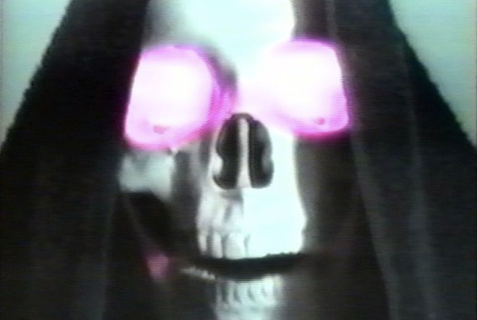
Center Rest
(Dir. Antonio Johns)
I saw this on a train. I was traveling from Seattle to Portland by train, and the person sitting next to me asked me if I wanted to watch a movie with him. READ MORE >
CENTERPIECE by Daniel S. Muehlmeier
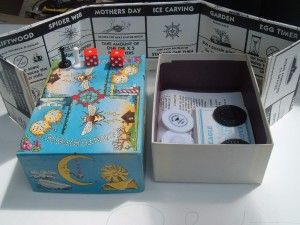 CENTERPIECE
CENTERPIECE
by Daniel Muehlmeier/Lee Mothes
Warm Wax Inc., 1991
2 players / 30 minutes / $19.99 from eBay
CENTERPIECE is a board game designed by Daniel S. Muehlmeier, self-described “unlocker of secrets,” with art by Lee Mothes. It was taken off a Goa’uld mother ship.
You won’t find CENTERPIECE in the Toys & Games section of your local Barnes & Noble. The game, originally published in 1991, is a notoriously tough sell. “I do well in the twenty-dollar range,” said the author in his recent Kickstarter campaign, which managed to raise only $615 of funds from 23 backers. “I keep a few game boxes in my cars back-window. Creating sales proved tough for me.”
“One restaurant placed five games. Near where people pay. All five disappeared, I never even restock them. Example of really bad-marketing skills. Yet I’m really looking forward, to direct mail to customers.” Following the close of the Kickstarter, the game is now being listed on eBay under the heading “tradition game, toys and Hobbies.” Yet this is just a stepping stone for Muehlmeier, who would eventually like to see his game displayed in a contemporary art museum.
Nor is this a delusionary ambition. Bad-marketing skills aside, Muehlmeier’s creation intrigues; in fact, it’s best approached from the vantage point of art (as opposed to game) criticism. Even taken as a game, CENTERPIECE is an answering shot to the pet theory that the whole of a game’s value rests within its mechanical core, for which the superficial elements of theme and appearance serve as mere window dressing.
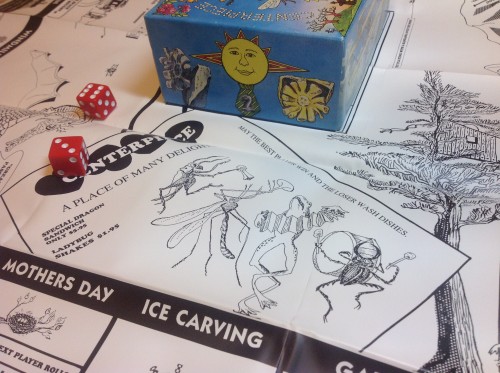
CENTERPIECE‘s mechanisms of play are invitingly familiar. In fact, CENTERPIECE could accurately be called a pastiche of several games known to all American children: Monopoly, Parcheesi, Chutes and Ladders. Pastiche in both senses of the word, since CENTERPIECE‘s core mechanisms walk a tricky line between quotidian simplicity and schizophrenic montage, made no more easily reconciled by the often indecipherable rules, which read like an antique riddle. “Players are encouraged to use common sense,” the single-leaf rules advise. “For example, if both players are sent to the Bird Cage; because a player rolled a two, while visiting the Honey Jar space. The player who rolled snake-eyes would roll for doubles first. Both player would stay for three turns, unless doubles were rolled.”
Once mastered, CENTERPIECE is an almost fully luck-driven affair, a roll-and-move game destined to be despised by the modern board game community, who have become spoiled by worker placement, economic engines, asymmetric player roles, and all the other innovations the last two decades have brought to the medium (remember, CENTERPIECE is a time capsule from the early ’90s, although aesthetically, it hearkens to an even earlier era). Yet the game’s “superficial” elements are not to be discounted, for they create a metaphorical frame or structure as the game plays out, turning a simple reimagining of Monopoly into something that far exceeds the sum of its parts.
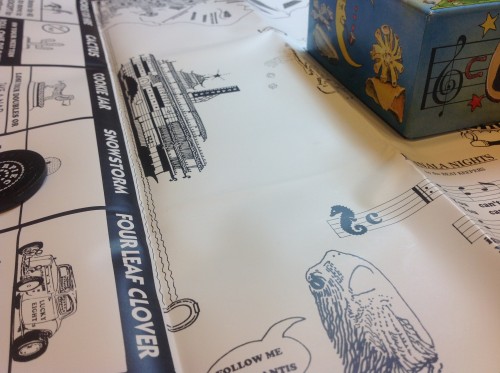
As if to embody this very statement, the first bread crumb along CENTERPIECE‘s allegorical trail is the fact that the game’s box, colorfully illustrated by artist Lee Mothes, is also central—both literally and figuratively—to its gameplay. Once the board has been unfolded, the box top is placed at its center, a mechanically unimportant gesture that receives special emphasis in the game rules—and is hammered home with every turn, as the dice pounding off of its cardboard surface speak testimony to its substance (that the dice must be rolled off of the box top is another apparently superficial but ritualistically significant gesture). As the eponymous centerpiece, this raised rectangle of cardboard naturally draws the eye—it is the only spot of color in an otherwise black-and-white composition—while hiding the game’s deepest secrets. A display of puzzle pieces nestled beneath track the players’ scores, and it is to Muehlmeier’s infinite credit that he keeps this indispensible information hidden away until the moment that the box is lifted, a moment that always coincides with a change in the data under scrutiny. It is the uncertainty principle actualized.
December 4th, 2013 / 12:00 pm






